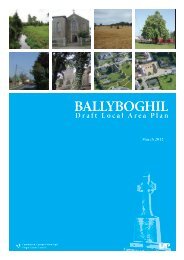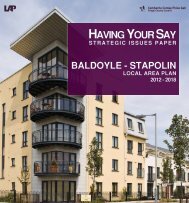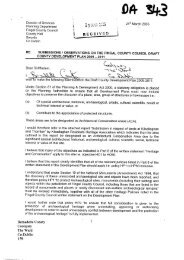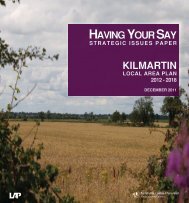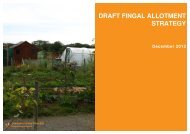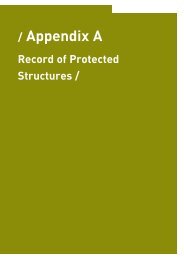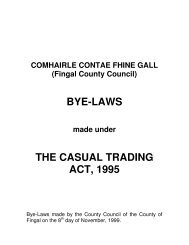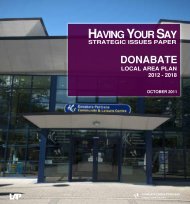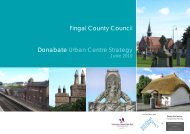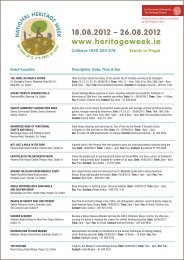Swords Masterplan - Fingal County Council
Swords Masterplan - Fingal County Council
Swords Masterplan - Fingal County Council
You also want an ePaper? Increase the reach of your titles
YUMPU automatically turns print PDFs into web optimized ePapers that Google loves.
10.1 Introduction<br />
The urban design framework for the <strong>Swords</strong> Town Centre <strong>Masterplan</strong> provides a<br />
guide to suitable building heights for new sustainable development, whilst<br />
protecting the established residential and visual amenity of the area.<br />
Context is paramount and an appropriate response is fundamental in respect of<br />
five key criteria:<br />
1. Respect of the Amenity of Existing Development: Where the heights of<br />
proposed buildings require set back distances and landscape screening<br />
elements to protect the privacy of local residents adjoining development areas.<br />
2. A Positive Contribution to the Public Realm: Buildings exceeding the general<br />
context heights and unscreened by natural features will have to demonstrate<br />
their urban design merits both in terms of outward appearance and benefits<br />
accruing in terms of open space and additional amenities provided.<br />
3. Heritage Valued: Protection of key vistas, of local protected structures and<br />
the social and historic heritage of the area is important. Heights and massing<br />
should not adversely impact on the innate and valued historic character of<br />
the area.<br />
4. Landmark Role: Areas of particular significance, higher density and increased<br />
activity can be identified via taller buildings acting as landmarks. The location<br />
of taller buildings can be part of the process of creating an identity for the<br />
town. It requires both a rationale for locating these taller elements and an<br />
understanding of their desirability and viability in those locations.<br />
5. Sustainable Compact Development: New urban development must follow<br />
the logic for compact form at higher densities to be sustainable. Urban sites,<br />
especially in the vicinity of mass transit systems such as the Metro, can<br />
support higher densities than suburban or rural locations. In order to<br />
maximise such limited and valuable sites it is appropriate to consider a scale<br />
change in the interests of creating mixed urban developments with lower<br />
environmental impacts.<br />
S W O R D S M A S T E R P L A N<br />
10.0 <strong>Swords</strong> Town Centre Heights Strategy<br />
10.2 Overview<br />
The heights strategy for each of the character areas is explained in detail in their<br />
respective sections throughout the <strong>Masterplan</strong> document, however the overriding<br />
features are as follows:<br />
1. <strong>Swords</strong> Town Setting<br />
There are four main elements defining the town setting.<br />
● Topography and Landscape<br />
The gently rolling topography and natural tree cover of the <strong>Swords</strong> environs<br />
provides few long distance or local views in and around the town. The skyline<br />
has no pronounced built forms or profile defining the Town Centre and only<br />
glimpses of fragments of buildings are visible within the general tree canopy.<br />
This enveloping nature of the natural tree cover is further enhanced by the<br />
verge planting of the R132 which effectively channels views along the<br />
roadway. St. Columba’s Church and Round Tower, the only historic<br />
monument of any height, is hardly noticeable as it barely emerges from the<br />
tree line except in a few locations within the Town Centre itself. Views of St.<br />
Columba’s Church and Round Tower from within the Town Centre shall be<br />
protected.<br />
The town is endowed with extensive open space in the form, predominately,<br />
of natural landscape centred around the Ward and Broadmeadow River<br />
Valleys. These landscape assets are a key defining quality of the town. As<br />
such both their amenity value and potential to inform the identity of <strong>Swords</strong><br />
should be considered with respect to development proposals and appropriate<br />
height or massing. Views into and from these public open spaces should be<br />
both protected and enhanced. The heights strategy identifies these open<br />
spaces and key views through them.<br />
● M1 Motorway Presence<br />
The motorway is relatively distant from and offers little prospect to the Town<br />
Centre. Prominent forms visible from the motorway are the industrial sheds<br />
of the <strong>Swords</strong> Business Park area to the east and recent housing<br />
developments further south. Much of the motorway is a cutting, except to the<br />
North where it rises to cross the Broadmeadow Estuary. Opportunities to<br />
announce the identity of <strong>Swords</strong> to passing traffic on this significant<br />
transport corridor exist on development lands adjacent the motorway in the<br />
Seatown and Lissenhall areas and these locations are identified on the<br />
heights diagram.<br />
● R132 Approach<br />
The strong tree lined parkway condition to the R132 limits the appreciation of<br />
height in the adjacent developed areas. Little if any buildings are visible from<br />
the R132 as it passes through <strong>Swords</strong> to the east of the current Town Centre.<br />
1 0 3<br />
There is no overt identification of the location of the Town Centre as the<br />
parkway condition of the R132 is nearly constant and there are no significant<br />
buildings (other than the Pavilions Shopping Centre). The parkway planting<br />
does an effective job in masking the disparate heights and forms of the<br />
differing uses along the R132. The height and density of the parkway trees<br />
play a positive role in projecting the image of <strong>Swords</strong> as a ‘green’ location<br />
and should be protected and enhanced as a key element of the vision of<br />
<strong>Swords</strong> as ‘an emerging green city’.<br />
● Residential Areas<br />
Much of the existing residential areas of <strong>Swords</strong> are made up of 1 to 2 storey<br />
houses. The heights strategy for areas located outside of the Town Centre<br />
areas will respond to this existing context as well as the need to create a<br />
hierarchy of public spaces and a local centre focus where the heights<br />
increase to up to 4 floors to create a stronger sense of enclosure and<br />
intensity of activity.<br />
● Metro North<br />
The arrival of Metro North will change the current highway orientated R132<br />
route through <strong>Swords</strong> by attracting development around the Stop locations.<br />
Some of these developments are subject to future LAPs, but higher buildings<br />
will logically be centred on the areas around the future Metro Stops of<br />
Fosterstown, <strong>Swords</strong>, Seatown, Estuary and Lissenhall. Heights will<br />
decrease towards the existing residential areas, but will inevitably create a<br />
distinctive scale change at the stops and articulate the route along the R132.<br />
Significant areas of undeveloped land, or areas requiring rezoning to reflect<br />
their current and future status within the <strong>Swords</strong> Town environs, lie adjacent<br />
most of the Metro Stop locations. Heights in these locations are set to reflect<br />
the local context, the opportunity to create a distinctive identity for the area<br />
and best practise on sustainable development densities/mix of uses.




